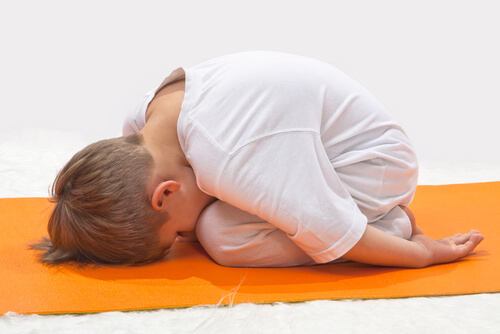The Turtle Technique: a Method of Self Control

The turtle technique is a tool to help children control their emotions. As part of children’s social education, it also addresses certain parenting errors that lead to out-of-control behavior in kids.
Many parents today are confused about the best way to raise their children. They are afraid of imposing too many restrictions.
At the same time, they know that it is necessary to set boundaries. This ambiguity gives rise to a lack of emotional control in children.
A lack of self-control in little ones can generally be seen in the typical childhood tantrum. In a fit of rage, kids kick and scream uncontrollably.
Sometimes, they are able to wear their parents down in this way and get exactly what they want. The turtle technique helps to avoid this.
The turtle technique
Many parents describe their children as hyperactive. Often, they are just worried and uneasy.
Deficient parenting confuses them and makes them anxious. They express this anxiety through erratic behavior, disobedience and mood swings.
If this is the case, the turtle technique is an efficient way to promote self-control. It consists of just four steps:
Teach the child to retreat into their shell
You can explain the turtle technique to your children with a story about a little turtle who is having trouble at school. She answers back to her teachers and lashes out at her friends when they tease her.
Her teacher shows her that when she is very angry, she can retreat into her shell and count to ten. The little turtle puts this advice into action and all of her problems are solved, as if by magic.
You can teach your child to get into the position of a turtle, just like the one in the story. They should crouch down and put their head in their arms, as if they too had a shell to retreat into.
The turtle technique is a physical, tangible way to teach children introspection.

Working on muscle tension
While the child is in their shell, they should breathe very deeply. Tell your child to concentrate on breathing in and out slowly.
This will help them relax their muscles and eliminate the muscle tension that comes along with anger.
Looking for solutions
The child should think about what they will do when they come out of their shell. This means thinking about the solutions available to resolve the problem.
At this point, you could also make suggestions. Your child should make the final decision, however.
Moving out of the turtle position
Once your child knows how they will face the situation, it is time for them to come back out of their shell. The child should move out of the turtle posture and go about resolving the problem as they have decided.
Practice this technique until your child has fully understood and adopted it. Your child will come to understand that it is much more effective than a tantrum.
The benefits of the turtle technique
The turtle technique is particularly effective for very young children. It is generally suitable for children between 3 and 7 years of age.
A similar mechanism can be used with older children, however. Just adapt the steps according to their interests and preferences.

The main benefit of the turtle technique is to teach children to keep control of themselves. This method has many other benefits, however. These include:
- Developing autonomy. If your child feels like they have ownership of their emotions, they will also maintain more control of their behavior. This gives them greater autonomy and self-confidence.
- Learning to trust their reasoning. Your little one will gradually come to understand that it is always best to think before acting. They will notice that their actions are more effective when they do this. This will be an important lesson for their adult life.
- Reducing anxiety. If your child feels that they have more control, they will also feel more secure. By developing more assertive behavior, they will also have less conflict in their relationships.
- Increased self-esteem. The turtle technique allows little ones to develop a better opinion of themselves. This, in turn, will lead to increased self-esteem.
- Increased responsibility. It is your child who evaluates and decides on the solution to adopt. This helps children to understand that they are responsible for their actions.
The turtle technique is a tool to help children control their emotions. As part of children’s social education, it also addresses certain parenting errors that lead to out-of-control behavior in kids.
Many parents today are confused about the best way to raise their children. They are afraid of imposing too many restrictions.
At the same time, they know that it is necessary to set boundaries. This ambiguity gives rise to a lack of emotional control in children.
A lack of self-control in little ones can generally be seen in the typical childhood tantrum. In a fit of rage, kids kick and scream uncontrollably.
Sometimes, they are able to wear their parents down in this way and get exactly what they want. The turtle technique helps to avoid this.
The turtle technique
Many parents describe their children as hyperactive. Often, they are just worried and uneasy.
Deficient parenting confuses them and makes them anxious. They express this anxiety through erratic behavior, disobedience and mood swings.
If this is the case, the turtle technique is an efficient way to promote self-control. It consists of just four steps:
Teach the child to retreat into their shell
You can explain the turtle technique to your children with a story about a little turtle who is having trouble at school. She answers back to her teachers and lashes out at her friends when they tease her.
Her teacher shows her that when she is very angry, she can retreat into her shell and count to ten. The little turtle puts this advice into action and all of her problems are solved, as if by magic.
You can teach your child to get into the position of a turtle, just like the one in the story. They should crouch down and put their head in their arms, as if they too had a shell to retreat into.
The turtle technique is a physical, tangible way to teach children introspection.

Working on muscle tension
While the child is in their shell, they should breathe very deeply. Tell your child to concentrate on breathing in and out slowly.
This will help them relax their muscles and eliminate the muscle tension that comes along with anger.
Looking for solutions
The child should think about what they will do when they come out of their shell. This means thinking about the solutions available to resolve the problem.
At this point, you could also make suggestions. Your child should make the final decision, however.
Moving out of the turtle position
Once your child knows how they will face the situation, it is time for them to come back out of their shell. The child should move out of the turtle posture and go about resolving the problem as they have decided.
Practice this technique until your child has fully understood and adopted it. Your child will come to understand that it is much more effective than a tantrum.
The benefits of the turtle technique
The turtle technique is particularly effective for very young children. It is generally suitable for children between 3 and 7 years of age.
A similar mechanism can be used with older children, however. Just adapt the steps according to their interests and preferences.

The main benefit of the turtle technique is to teach children to keep control of themselves. This method has many other benefits, however. These include:
- Developing autonomy. If your child feels like they have ownership of their emotions, they will also maintain more control of their behavior. This gives them greater autonomy and self-confidence.
- Learning to trust their reasoning. Your little one will gradually come to understand that it is always best to think before acting. They will notice that their actions are more effective when they do this. This will be an important lesson for their adult life.
- Reducing anxiety. If your child feels that they have more control, they will also feel more secure. By developing more assertive behavior, they will also have less conflict in their relationships.
- Increased self-esteem. The turtle technique allows little ones to develop a better opinion of themselves. This, in turn, will lead to increased self-esteem.
- Increased responsibility. It is your child who evaluates and decides on the solution to adopt. This helps children to understand that they are responsible for their actions.
All cited sources were thoroughly reviewed by our team to ensure their quality, reliability, currency, and validity. The bibliography of this article was considered reliable and of academic or scientific accuracy.
- Schneider, M., & Robin, A. (1990). “LA TECNICA DE LA “TORTUGA”: UN METODO PARA EL AUTOCONTROL DE LA CONDUCTA IMPULSIVA”. T. Bonet. Problemas psicológicos en la infancia. Valencia: promolibro-Cinteco. https://www.orientacionandujar.es/wp-content/uploads/2019/12/la_tecnica_de_la_tortuga.pdf
This text is provided for informational purposes only and does not replace consultation with a professional. If in doubt, consult your specialist.








